Caguas, Puerto Rico
Caguas (Spanish pronunciation: [ˈkaɣwas]), founded in 1775, is a city and municipality of Puerto Rico located in the Central Mountain Range of Puerto Rico, south of San Juan and Trujillo Alto, west of Gurabo and San Lorenzo, and east of Aguas Buenas, Cidra, and Cayey.
Caguas Municipio Autónomo de Caguas | |
|---|---|
Town and Municipality | |
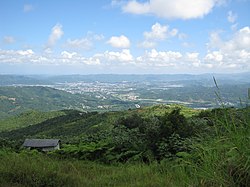 View of Caguas from Cerro Las Piñas in Beatriz, Cayey | |
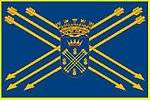 Flag 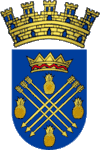 Coat of arms | |
| Nicknames: "La Ciudad del Turabo" (Turabo Valley), "La Ciudad Criolla" (Creole City), "La Cuna de los Trovadores" (Cradle of Trovadores) | |
| Anthem: "Centro y Corazón de Puerto Rico" | |
 Map of Puerto Rico highlighting Caguas Municipality | |
| Coordinates: 18°13′53″N 66°2′22″W | |
| Commonwealth | |
| Founded | January 1, 1775 |
| Wards | |
| Government | |
| • Mayor | William Miranda Torres (PPD) |
| • Senatorial dist. | 7 |
| • Representative dist. | 31,32 |
| Area | |
| • Total | 59.07 sq mi (153.00 km2) |
| • Land | 58.68 sq mi (151.97 km2) |
| • Water | 0.40 sq mi (1.03 km2) |
| Elevation | 211.0 ft (64.3 m) |
| Population (2010) | |
| • Total | 142,893 |
| • Density | 2,400/sq mi (930/km2) |
| Demonym(s) | Cagüeños caguenses |
| Ethnicity (2000 Census)[1] | |
| • White | 84.5% |
| • Black | 7.8% |
| • American Indian/AN | 0.6% |
| • Asian | 0.3% |
| • Native Hawaiian/PI | 0.1% |
| Time zone | UTC-4 (AST) |
| ZIP Codes | 00725, 00726, 00727 |
| Area code(s) | 787/939 |
| Major routes | |
| Website | caguas.gov.pr |
Caguas is located 20 miles (32 km) from San Juan. It is known as El Valle del Turabo (Turabo Valley), La Ciudad Criolla (The Creole City) and La Cuna de los Trovadores (The Cradle of the Trovadores).[2] Its name originates from the Taíno cacique Caguax. Caguas is a principal city of both the San Juan-Caguas-Guaynabo Metropolitan Statistical Area and the San Juan-Caguas-Fajardo Combined Statistical Area.[3]
History
Caguas was founded on January 1, 1775, as San Sebastián del Piñal de Caguax, with the name later shortened and modernized to its current form. Caguax was a local Taíno chief and early convert to Christianity. Caguas' construction was finished in 1779, in 1820 it was declared a valley and in 1894 it became a city.[4]
The United States took control of Puerto Rico from Spain in the aftermath of the Spanish-American War under the terms of the Treaty of Paris of 1898 and conducted its first census of Puerto Rico in 1899, finding that the Caguas was 19,857.[5]
In 2002, Caguas was the site of the 2002 USAF Hercules air disaster.[6]
Hurricane Maria
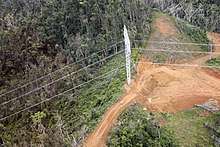
Hurricane Maria on September 20, 2017 triggered numerous landslides in Caguas with the significant amount of rainfall.[7][8]
Geography
Caguas is located in the largest valley in Puerto Rico, the "Valle de Caguas" (or "Valle del Turabo-Turabo Valley")[9] which it shares with Gurabo and part of Aguas Buenas. It is located approximately 30 minutes from the coastline both on the east (Humacao) and the north (San Juan), and is divided from the Gurabo portion of the valley by the river of the same name. It is east of Aguas Buenas and Cidra, north of Cayey, south of San Juan, and west of Gurabo and Trujillo Alto. It also shares borders with Guayama and Patillas via a five-point border, with Cayey and San Lorenzo. At this point there are two tall antennas which provide signal to Puerto Rico's principal TV stations such as WKAQ-TV and WAPA-TV. No road passes exactly at this point, and it can be approached nearby through Puerto Rico Highway 184. Being a valley, Caguas has the distinction of being relatively flat except near the borders with all the mentioned municipalities except Gurabo.[10]
Water features
- The Río Grande de Loíza divides this municipality from Gurabo.
- Other Rivers: Río Turabo, Río Caguitas, Río Cañaboncito, Río Bairoa and Río Cañas.
Climate
The climate is classified as a Tropical monsoon climate, meaning the daily mean temperature from month to month is never less than 64.4 °F (18 °C), and there is a distinct wet and dry season. Rainfall is common in relative abundance throughout most of the year, although there is less rain than in the eastern coastal valleys. The land, however, is fertile and deep.
| Month | Jan | Feb | Mar | Apr | May | Jun | Jul | Aug | Sep | Oct | Nov | Dec | Year |
|---|---|---|---|---|---|---|---|---|---|---|---|---|---|
| Record high °F (°C) | 92 (33) |
93 (34) |
95 (35) |
95 (35) |
97 (36) |
99 (37) |
99 (37) |
98 (37) |
101 (38) |
99 (37) |
95 (35) |
95 (35) |
101 (38) |
| Average high °F (°C) | 79.3 (26.3) |
80.9 (27.2) |
86.4 (30.2) |
88.1 (31.2) |
89.4 (31.9) |
90.5 (32.5) |
90.7 (32.6) |
91.1 (32.8) |
91.0 (32.8) |
90.0 (32.2) |
87.4 (30.8) |
84.9 (29.4) |
87.5 (30.8) |
| Daily mean °F (°C) | 70.9 (21.6) |
71.1 (21.7) |
74.3 (23.5) |
77.1 (25.1) |
79.6 (26.4) |
81.4 (27.4) |
82.7 (28.2) |
82.5 (28.1) |
82.8 (28.2) |
81.6 (27.6) |
78.1 (25.6) |
75.4 (24.1) |
78.1 (25.6) |
| Average low °F (°C) | 62.5 (16.9) |
61.1 (16.2) |
62.3 (16.8) |
66.0 (18.9) |
69.8 (21.0) |
72.4 (22.4) |
74.7 (23.7) |
74.0 (23.3) |
74.7 (23.7) |
73.2 (22.9) |
68.7 (20.4) |
65.8 (18.8) |
68.8 (20.4) |
| Record low °F (°C) | 50 (10) |
50 (10) |
49 (9) |
56 (13) |
62 (17) |
65 (18) |
66 (19) |
67 (19) |
66 (19) |
64 (18) |
59 (15) |
57 (14) |
49 (9) |
| Average rainfall inches (mm) | 3.05 (77) |
2.68 (68) |
1.39 (35) |
4.32 (110) |
10.46 (266) |
4.22 (107) |
3.46 (88) |
5.03 (128) |
9.74 (247) |
7.12 (181) |
7.87 (200) |
4.20 (107) |
59.52 (1,512) |
| Average snowfall inches (cm) | 0 (0) |
0 (0) |
0 (0) |
0 (0) |
0 (0) |
0 (0) |
0 (0) |
0 (0) |
0 (0) |
0 (0) |
0 (0) |
0 (0) |
0 (0) |
| Average rainy days (≥ 0.10) | 9 | 7 | 6 | 12 | 18 | 11 | 8 | 10 | 14 | 10 | 18 | 9 | 100 |
| Average snowy days (≥ 1.00) | 0 | 0 | 0 | 0 | 0 | 0 | 0 | 0 | 0 | 0 | 0 | 0 | 0 |
| Source: Southeast Regional Climate Center [11] | |||||||||||||
Barrios
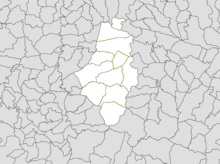
Like all municipalities of Puerto Rico, Caguas is subdivided into barrios:[12][13][14]
Sectors
Barrios (which are like minor civil divisions)[15] in turn are further subdivided into smaller local populated place areas/units called sectores (sectors in English). The types of sectores may vary, from normally sector to urbanización to reparto to barriada to residencial, among others.[16][17][18]
Special Communities
Of the 742 places on the list of Comunidades Especiales de Puerto Rico, the following barrios, communities, sectors, or neighborhoods were in Caguas in 2014: Bairoa La 25, Morales neighborhood, Parcelas Viejas in Borinquén, Sector La Barra, and Comunidad La Quebrada in Río Cañas, Hoyo Frío in Las Carolinas, Lajitas, Las Carolinas, Los Muchos, Los Panes in Beatriz, and Savarona.[19][20]
Tourism
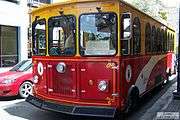
Landmarks and places of interest
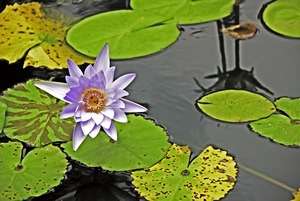
- Botanical and Cultural Gardens
- Caguas Historical Museum
- Caguas Cathedral
- Coquí Villa
- Hacienda Catalina Ruins
- Hacienda Cofresí
- Hacienda Country Club
- Jardín Botánico y Cultural William Miranda Marín
- La Casa de Ajedrez (The House of Chess)
- Tobacco Museum
- Catedral Dulce Nombre de Jesus (In town plaza founded in 1729 and constructed in 1774).
Culture
Festivals and events
Caguas celebrates its patron saint festival in July. The Fiestas Patronales de Nuestra Sra. del Carmen is a religious and cultural celebration that generally features parades, games, artisans, amusement rides, regional food, and live entertainment.[10]
Other festivals and events include:
- Rosario Cantado a los Reyes – 4 January
- Three Kings Festival – 5 January
- Criolla Beatriz – February
- Criolla Borinquen Fair – March
- Criolla Cañabón Fair – April
- Felipe "La Voz" Rodríguez' Birthday – 8 May
- Al Fresco – Every last Friday of each month
- Cross Festival – 23–31 May
- Typical Criole Festival – 1–2 June
- Latin American Musical
Sports
The Criollos de Caguas baseball team is considered one of the greatest of all-time in all of Latin America, having won 18 national Puerto Rico titles and 5 Caribbean World Series titles The team is a member of the Liga de Béisbol Profesional de Puerto Rico (LBPPR). Three of the first five Puerto Ricans that played Major League Baseball in the U.S. mainland, at one point in their careers played for the Criollos de Caguas (Luis Rodríguez Olmo, Victor Pellot Power, Roberto Clemente).
The Criollos de Caguas basketball team, founded in 1968 by Dr. Héctor "Tato" Dávila and Lcdo. Libertario Pérez Rodríguez, was a basketball team that did not enjoy as much success as their baseball counterparts. However, in the early 2000s, they showed a lot of progress by reaching the national playoffs various times. The team was a member of the BSN. In 2006, the team won its first BSN national basketball championship, defeating Flor Melendez and his Santurce Crabbers in five games.
Caguas is home to the Bairoa Gym, one of the most important boxing gyms in all Puerto Rico and a place where many visiting champions have trained at; such as boxing Welterweight Champion Miguel Cotto, his brother Jose Miguel, Alberto Mercado, Juan Carazo, Alfredo Escalera and others.
The Criollas de Caguas women's volleyball team has won 9 national Puerto Rico titles and has made it to the finals more than 15 times. The team is a member of the Liga de Voleibol Superior Femenino (LVSF).
The Criollos de Caguas FC soccer team is considered one of the most successful clubs in the island winning multiple tournaments and cups in Puerto Rican soccer including the National League Title in 2015.
Economy
In September 2005, city mayor William Miranda Marin levied the first municipal tax in Puerto Rico via city ordinance. Area merchants now charge a one cent tax for every dollar spent at all retail businesses. The tax has become known around the island as the "Willie Tax." It resulted in an estimated $500,000 monthly income for the city. However, the municipal tax was increased to 1.5% after the establishment of the 5.5% state tax for a total of 7% and the tax was declared illegal by the Puerto Rico's Supreme Court.
During 2006, Miranda Marin began calling Caguas "El Nuevo Pais de Caguas" ("The New Country of Caguas").
Agriculture
During the early part of the 20th century, Caguas hosted one of Puerto Rico's most important sugar manufacturers, which gave employment to thousands of Cagüeños.
Business
Numerous businesses and important buildings have opened in Caguas since the 1970s, including the imposing 23 story apartment building Caguas Tower, its adjacent competitors Bonneville Apartments, and the 10 floor Menonita Hospital. There are also several shopping centers:
- Plaza del Carmen Mall,
- Plaza Centro Mall
- Las Catalinas Mall
- Los Prados Mall
- Bairoa Shopping Center
- Villa Blanca Mall
- Angora Shopping Center
- Plaza Degetau
- Plaza Caguitas
- Del Rio Shopping Center
- Metro Plaza (Caguas, Puerto Rico)
Demographics
The United States took control of Puerto Rico from Spain in the aftermath of the Spanish-American War under the terms of the Treaty of Paris of 1898 and conducted its first census of Puerto Rico, finding that the population of Caguas was 19,857.
| Historical population | |||
|---|---|---|---|
| Census | Pop. | %± | |
| 1900 | 19,857 | — | |
| 1910 | 27,160 | 36.8% | |
| 1920 | 35,920 | 32.3% | |
| 1930 | 47,728 | 32.9% | |
| 1940 | 53,356 | 11.8% | |
| 1950 | 60,132 | 12.7% | |
| 1960 | 65,098 | 8.3% | |
| 1970 | 95,661 | 46.9% | |
| 1980 | 117,959 | 23.3% | |
| 1990 | 133,447 | 13.1% | |
| 2000 | 140,502 | 5.3% | |
| 2010 | 142,893 | 1.7% | |
| U.S. Decennial Census[21] 1899 (shown as 1900)[22] 1910-1930[23] 1930-1950[24] 1960-2000[25] 2010[13] | |||
Government
All municipalities in Puerto Rico are administered by a mayor, elected every four years. The mayor of the city of Caguas were
1953 to 1969 - Angel Rivera PPD
1969 to 1973 - Miguel Hernandez Rodriguez (New Progressive Party (PNP))
1973 to 1977 - Angel O. Berrios Diaz (PPD)
1977 to 1981 - Miguel Hernandez Rodriguez (PNP)
1981 to 1997 - Angel O. Berrios Diaz (PPD)
1997 to 2010 - William Miranda Marín (PPD)
2010 to present - William Miranda Torres (PPD)
The city belongs to the Senatorial district VII (Humacao), which is represented by two Senators. In 2016, Miguel Laureano (PNP) and José Luis Dalmau (PPD) were elected as District Senators.
Symbols
Flag and coat of arms
The colors blue and gold were chosen for the shield, distinctive of the city of Caguas. The figures symbolize both the indigenous and Christian origins of this city.
The coat of arms consists of a shield with a blue field. Upon the field are two sets of three golden arrows, forming a cross of St. Andrew. Above the cross is a crown which represents Caguax, cacique of the Turabo Valley at the time of the arrival of the Spanish conquerors.
Arrows were used as a remembrance of the first Christian place of worship established in the region which was dedicated under the patronage of St. Sebastian. There are pineapples interspersed to reflect the native agriculture. A castellated wall surmounts the shield to show the city's having been granted status as a municipality by the Spanish Crown.
On the flag, the shield sits atop another blue field on which the cross of arrows is repeated.
Transportation
Public transportation in Caguas, as in most of Puerto Rico, is limited to small "guaguas públicas" (Mini Bus). There is inexpensive but slow service to and from San Juan and Rio Piedras. Within Caguas, several buses and taxis serve the town.
A "light interurban rail" system connecting Caguas to San Juan was in the planning stages and discarded due to lack of funding.
Caguas is served by one freeway, one tolled expressway and one main divided highway. Puerto Rico Highway 30 connects Caguas to the east. There is no freeway/expressway to the west, due mainly to the fact that there is no sufficient population west of Caguas to develop a new freeway or expressway; good access to the municipalities of Cidra(southwest) and Aguas Buenas(northwest) are possible via PR-172 and PR-156, respectively. Puerto Rico Highway 52 connects Caguas to the north (San Juan) and south (Cayey, Ponce). Puerto Rico Highway 1 is an alternate route to San Juan and Guaynabo with two lanes per direction; in south Caguas it becomes rural near Borinquen, therefore the only good access to Cayey is the expressway (PR-52) and a $1.00 toll has to be paid (only in the south direction). The only municipality bordering Caguas with a poor-access road is San Lorenzo, via PR-183; but good access to San Lorenzo is possible by entering Gurabo via PR-30, and then taking PR-203 south.
Luis Muñoz Marín International Airport is about 35 minutes away by car.
There are 86 bridges in Caguas.[26]
Education
High schools
- Colegio Católico Notre Dame
- Elohim Christian Academy
- New Generation Christian Academy (formerly CLA)
- Caguas Military Academy
- Colegio Bautista
- Colegio Católico San Juan Apóstol
- Academia Cristo de los Milagros
- Dr. Juan José Osuna High school
- José Gautier Benítez High school
- Manuela Toro Morice High School
- Republic of Costa Rica Vocacional High School of Caguas
- Eloisa Pascual "Bairoa III" High School
- Rio Cañas High School
- Santa Rosa Superior School
- Thomas Alva Edison School
- Colegio San José Superior
- Escuela Secundaria Especializada en Ciencias, Matemáticas y Tecnología (CIMATEC)
- Caguas Private School (CPS)
Higher education
- San Juan Bautista School of Medicine
- Huertas Junior College
- Instituto EDIC
- Columbia College
- Turabo University at Gurabo (Gurabo, Puerto Rico)
Health care
- Hospital Hima San Pablo
- Menonita Caguas Regional Hospital
- San Juan Bautista Medical Center
- Corporacion SANOS
Sister cities
Caguas, Puerto Rico is twinned with Southbridge, Massachusetts.
Gallery
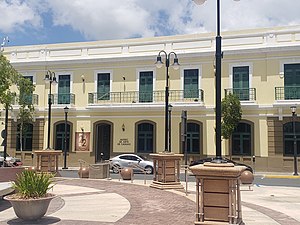 Museo de Arte de Caguas
Museo de Arte de Caguas The José Ignacio Quintón Center for Criollo Music, located at the corner of Calle Ruiz Belvis and Calle Intendente Ramírez in Caguas, Puerto Rico. The center occupies the historic First Baptist Church of Caguas (built 1907–1909), and is listed on the U.S. National Register of Historic Places.
The José Ignacio Quintón Center for Criollo Music, located at the corner of Calle Ruiz Belvis and Calle Intendente Ramírez in Caguas, Puerto Rico. The center occupies the historic First Baptist Church of Caguas (built 1907–1909), and is listed on the U.S. National Register of Historic Places.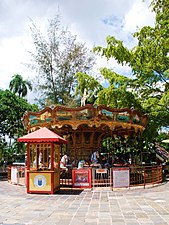 Carousel in Plaza de Caguas
Carousel in Plaza de Caguas Caguas cathedral "Dulce Nombre de Jesús" founded in 1729. On the facade hangs an image of native son Blessed Carlos Manuel Rodríguez, whose body rests in the cathedral.
Caguas cathedral "Dulce Nombre de Jesús" founded in 1729. On the facade hangs an image of native son Blessed Carlos Manuel Rodríguez, whose body rests in the cathedral.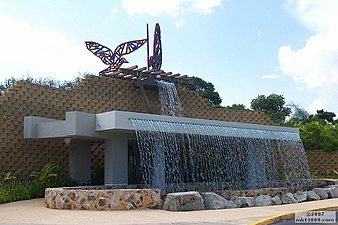 Entrance to the Botanical and Cultural Gardens in Caguas
Entrance to the Botanical and Cultural Gardens in Caguas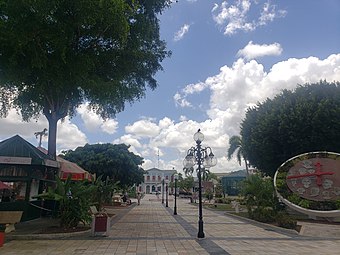 Main square for recreation, Plaza de Recreo Santiago R. Palmer in Caguas barrio-pueblo
Main square for recreation, Plaza de Recreo Santiago R. Palmer in Caguas barrio-pueblo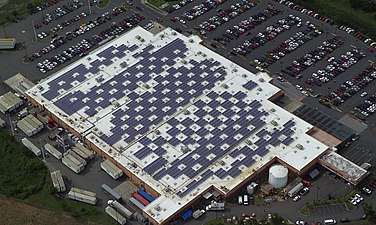 The Walmart in Caguas, Puerto Rico is one of five Walmart facilities on the island equipped with solar panels.
The Walmart in Caguas, Puerto Rico is one of five Walmart facilities on the island equipped with solar panels.
Notes
- "Demographics/Ethnic U.S 2000 census" (PDF). Topeurtorico.org. Archived (PDF) from the original on 2008-02-16. Retrieved 30 November 2017.
- Florencio Morales Ramos: Ramito, “el Cantor de la Montaña”. Archived 2017-11-07 at the Wayback Machine David Morales. Our Country Music. Undated. Accessed 8 December 2018.
- Grupo Editorial EPRL (June 4, 2015). Fundación Puertoriqueña de las Humanidades (ed.). "Caguas". Enciclopedia de Puerto Rico (in Spanish). Archived from the original on 2015-06-29. Retrieved June 28, 2015.
- "Caguas, Puerto Rico". Welcome.topuertorico.org. Archived from the original on 2016-09-12. Retrieved 15 September 2016.
- Joseph Prentiss Sanger; Henry Gannett; Walter Francis Willcox (1900). Informe sobre el censo de Puerto Rico, 1899, United States. War Dept. Porto Rico Census Office (in Spanish). Imprenta del gobierno. p. 161.
- Ranter, Harro. "ASN Aircraft accident Lockheed MC-130H Hercules 90-0161 Caguas". Aviation-safety.net. Archived from the original on 2012-10-24. Retrieved 15 September 2016.
- "Preliminary Locations of Landslide Impacts from Hurricane Maria, Puerto Rico". USGS Landslide Hazards Program. USGS. Archived from the original on 2019-03-03. Retrieved 2019-03-03.
- "Preliminary Locations of Landslide Impacts from Hurricane Maria, Puerto Rico" (PDF). USGS Landslide Hazards Program. USGS. Archived (PDF) from the original on 2019-03-03. Retrieved 2019-03-03.
- "Orgullo y alegría en el Valle del Turabo". Elnuevodia.com. 19 January 2017. Archived from the original on 28 December 2018. Retrieved 30 November 2017.
- "Caguas Municipality". Fundación Puertorriqueña de las Humanidades (FPH). Archived from the original on 2019-06-04. Retrieved 2019-03-20.
- "CAGUAS, PUERTO RICO". The University of North Carolina (Chapel Hill campus). Archived from the original on 2013-08-08. Retrieved 26 October 2011.
- Gwillim Law (20 May 2015). Administrative Subdivisions of Countries: A Comprehensive World Reference, 1900 through 1998. McFarland. p. 300. ISBN 978-1-4766-0447-3. Retrieved 25 December 2018.
- Puerto Rico:2010:population and housing unit counts.pdf (PDF). U.S. Dept. of Commerce Economics and Statistics Administration U.S. Census Bureau. 2010. Archived (PDF) from the original on 2017-02-20. Retrieved 2018-12-28.
- "Map of Caguas at the Wayback Machine" (PDF). Archived from the original (PDF) on 2018-03-24. Retrieved 2018-12-29.
- "US Census Barrio-Pueblo definition". factfinder.com. US Census. Archived from the original on 13 May 2017. Retrieved 5 January 2019.
- "Agencia: Oficina del Coordinador General para el Financiamiento Socioeconómico y la Autogestión (Proposed 2016 Budget)". Puerto Rico Budgets (in Spanish). Retrieved 28 June 2019.
- Rivera Quintero, Marcia (2014), El vuelo de la esperanza: Proyecto de las Comunidades Especiales Puerto Rico, 1997-2004 (first ed.), San Juan, Puerto Rico Fundación Sila M. Calderón, ISBN 978-0-9820806-1-0
- "Leyes del 2001". Lex Juris Puerto Rico (in Spanish). Retrieved 24 June 2020.
- Rivera Quintero, Marcia (2014), El vuelo de la esperanza:Proyecto de las Comunidades Especiales Puerto Rico, 1997-2004 (Primera edición ed.), San Juan, Puerto Rico Fundación Sila M. Calderón, p. 273, ISBN 978-0-9820806-1-0
- "Comunidades Especiales de Puerto Rico" (in Spanish). 8 August 2011. Archived from the original on 24 June 2019. Retrieved 24 June 2019.
- "U.S. Decennial Census". United States Census Bureau. Archived from the original on February 13, 2020. Retrieved September 21, 2017.
- "Report of the Census of Porto Rico 1899". War Department Office Director Census of Porto Rico. Archived from the original on July 16, 2017. Retrieved September 21, 2017.
- "Table 3-Population of Municipalities: 1930 1920 and 1910" (PDF). United States Census Bureau. Archived (PDF) from the original on August 17, 2017. Retrieved September 21, 2017.
- "Table 4-Area and Population of Municipalities Urban and Rural: 1930 to 1950" (PDF). United States Census Bureau. Archived (PDF) from the original on August 30, 2015. Retrieved September 21, 2014.
- "Table 2 Population and Housing Units: 1960 to 2000" (PDF). United States Census Bureau. Archived (PDF) from the original on July 24, 2017. Retrieved September 21, 2017.
- "Caguas Bridges". National Bridge Inventory Data. US Dept. of Transportation. Archived from the original on 20 February 2019. Retrieved 19 February 2019.
References
- Caguas and its barrios, United States Census Bureau
- Carrasquillo, Rosa E. (2006). Our Landless Patria: Marginal Citizenship and Race in Caguas, Puerto Rico, 1880–1910. Lincoln, Nebraska: University of Nebraska Press. OCLC 61204347.
External links
| Wikivoyage has a travel guide for Caguas. |
- Official Web site (in Spanish)
- Eastern Center Virtual Library (in Spanish)
- Caguas Community Portal (in Spanish)
- Huertas Junior College (in Spanish)
- San Juan Bautista School of Medicine
- Columbia College (in Spanish)
- Grand Valley State University(in Spanish)
- Jardín Botánico y Cultural William Miranda Marín (in Spanish)
- Subdivision maps of Caguas